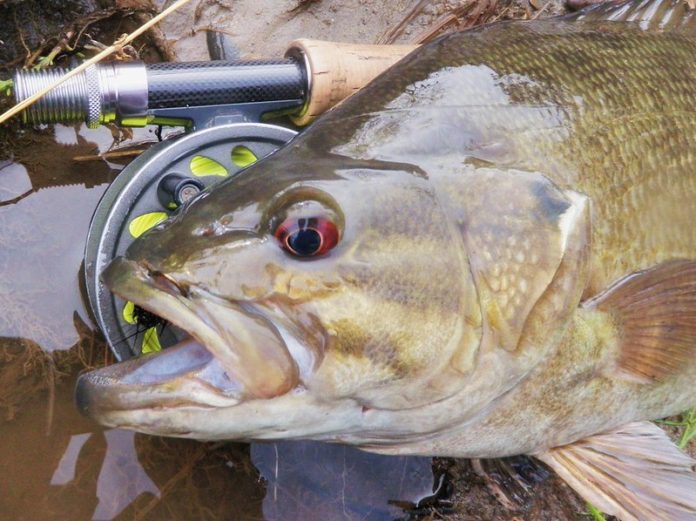When trout streams start to get too warm, the fishing for smallies often heats up.
Photo by Drew Price
The smallmouth bass (Micropterus dolomieu) goes by many nicknames—smallie, bronzeback, brownie, and brown bass, to name a few—which is a sign of its popularity in different parts of the country. It’s the most trout–like bass, in that it often lives in clean, cold rivers and feeds on insects, baitfish, and crayfish. For these reasons, even the most rigid trout snobs, who wouldn’t deign to cast to a largemouth or a panfish on a farm pond, will tie on a slider to tempt smallmouths to the surface. However, where the bass are encroaching on traditional trout water, often as a result of “bucket biology,” they are often viewed as an unwanted nuisance species.
Range and Life History
The original range of the smallmouth bass included the Great Lakes and St. Lawrence Seaway drainages—stretching from southern Quebec and New Hampshire to North Dakota—as well as the Mississippi River drainage as far south as Alabama. There were also native populations in the lower Hudson Bay basin. Smallmouths shared much of their range with largemouth bass (Micropterus salmoides); the two can coexist, but smallmouths generally prefer clearer, cooler water.
The construction of the Erie Canal in 1825 allowed the species to spread into central New York, and throughout the 19th century, smallmouths were stocked across the country, all the way to California. On many traditional trout-and-salmon rivers dams had caused the water to warm, and smallmouths were often stocked to replaced extinct coldwater game fish.
Their reputation as a hardy game fish and decent table fare made smallmouths in demand around the globe. In 1873, they were introduced in Belgium, the first international stocking. Since then, populations have been established in South Africa, Scandinavia, the British Isles, France, Germany, The Czech Republic, Mexico, Belize, Austria, Slovakia, Vietnam, Guam, Fiji, and Hawaii.

Smallmouth fans argue that the species fights much harder than trout.
Photo by Kip Vieth
Smallmouths are found in both rivers and larger still waters, and since they are visual predators, they require clear water. Rivers and lakes with a rocky or sandy substrate provide the best habitat, and like largemouths, smallmouths often relate to structure—such as rock outcroppings, logs, and weedbeds. Unlike largemouths, smallies can often be found in fairly swift currents and do not do well in turbid water or those with a soft substrate. The adaptability of the species is reflected in the diversity of waters famous for producing trophy catches—Maine’s coastal rivers, the nearshore reefs of Lake Erie, the high-desert tailwater of the John Day River, and the massive impoundments of the Mid-South.
Smallmouths spawn in spring, usually when the water temperature reaches about 60 degrees. Males build nests in gravel near shore or below current breaks, and they stand guard over the newly hatched fry. Smallmouths mature at age three or four, and they can live up to 12 years.
Trophy Water in Trouble
For decades, Pennsylvania’s Susquehanna River was a smallmouth Mecca, producing large fish and lots of them, but in the last decade, things have gone horribly wrong. Thousands of young fish died in the heat of late summer, showing strange lesions on their skin, and the population crashed. Soon, black splotches began appearing on mature fish, and some male fish had the beginnings of female eggs in their testes. The culprit seems to be pollution, but there is not yet agreement on the exact cause; some biologists believe it is a “perfect storm” of chemicals, waste, and higher water temperature. Many anglers and conservationists are pushing for the river to be declared “impaired,” which would make the river’s cleanup a priority and provide federal assistance.
World-Record Controversy
The current world record smallmouth is an 11-pound, 15-ounce monster caught by David Hayes on July 9, 1955 from Dale Hollow Lake, on the Tennessee-Kentucky Border. Hayes had the fish weighed on two scales, and there were plenty of witnesses. But a month later, a local fishing guide, Raymond “Doughbelly” Barlow, filed an affadavit claiming that he’d been told to stuff the fish with sinkers and boat parts before the weigh in. This document languished in an Army Corps of Engineers file until it was rediscovered in 1996, prompting the IGFA to disqualify the fish. But others rushed to Hayes’s defense, poking holes in the guide’s story. Despite the evidence, the IGFA did not reinstate Hayes’s record until 2005, the 50th anniversary of the catch.

The Upper Midwest offers some of the nation’s best smallmouth fishing.
Photo courtesy Kip Vieth
Techniques and Flies
Aside from the use of topwater bugs, smallmouth flies fall into categories similar to the ones we use for trout fishing. Most folks love to catch them on top. Small poppers or sliders—such as Tim Holschlag’s Blockhead or the classic Sneaky Pete—work best when cast to structure or against a woody bank. Other good surface patterns include terrestrials, dragon- and damselflies, and Hex mayflies.
Productive streamer patterns range from the standard Woolly Bugger and Clouser Minnow to the gaudy Shenk’s White Streamer, but most baitfish patterns will work in the right situation. In waters with lots of crayfish, tie on a Clouser Crayfish or a Mike’s Gorgon Craw and hop it along the bottom.
Perhaps the least popular method for catching smallmouths is nymphing, but this can be the answer when nothing else is working. Patterns with a lot of motion, such as a Brown Rubberlegs, work best.
Credit: Source link































